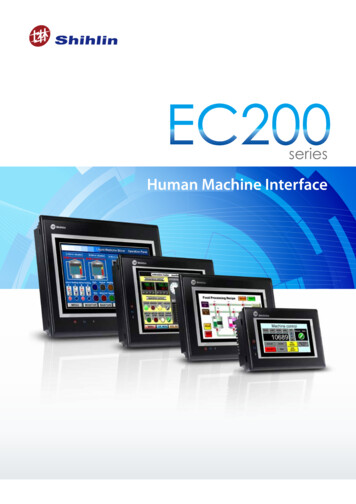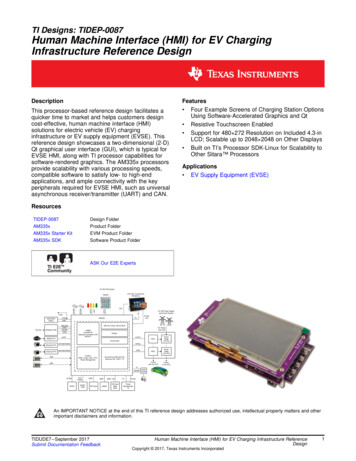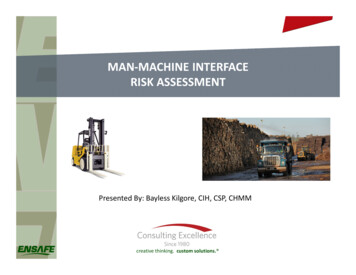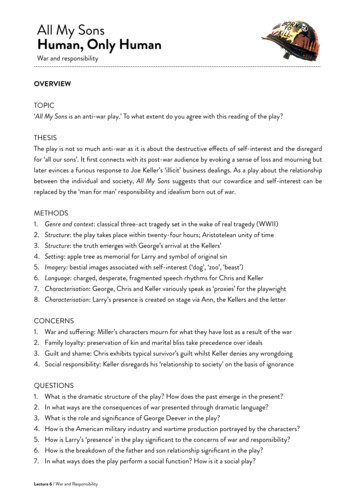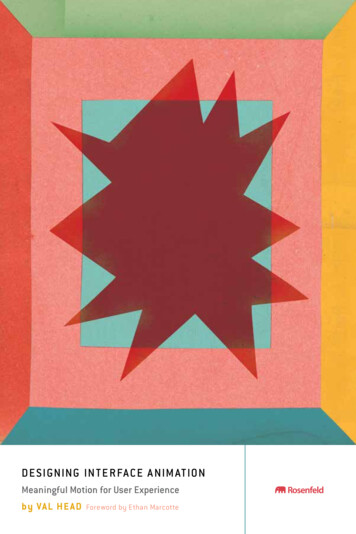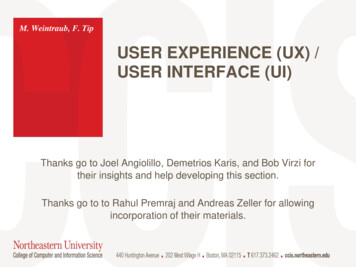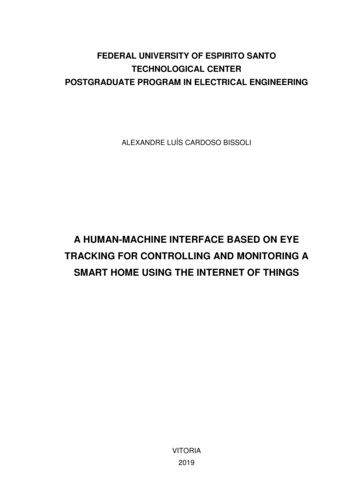
Transcription
FEDERAL UNIVERSITY OF ESPIRITO SANTOTECHNOLOGICAL CENTERPOSTGRADUATE PROGRAM IN ELECTRICAL ENGINEERINGALEXANDRE LUÍS CARDOSO BISSOLIA HUMAN-MACHINE INTERFACE BASED ON EYETRACKING FOR CONTROLLING AND MONITORING ASMART HOME USING THE INTERNET OF THINGSVITORIA2019
ALEANDRE LUÍS CARDOSO BISSOLIA HUMAN-MACHINE INTERFACE BASED ON EYETRACKING FOR CONTROLLING AND MONITORING ASMART HOME USING THE INTERNET OF THINGSPhD Thesis presented to the PostgraduateProgram in Electrical Engineering of the ment to obtain the degree of Doctor eandareaIntelligentAutomation.Advisor: Dr. Teodiano Freire Bastos FilhoCo-advisor: Dr. Lucas Frizera EncarnaçãoVITORIA2019of
Ficha catalográfica disponibilizada pelo Sistema Integrado deBibliotecas - SIBI/UFES e elaborada pelo autorB623hBissoli, Alexandre Luís Cardoso, 1990BisA Human-Machine Interface Based on Eye Tracking forControlling and Monitoring a Smart Home Using the Internet ofThings / Alexandre Luís Cardoso Bissoli. - 2019.Bis105 f. : il.BisOrientador: Teodiano Freire Bastos Filho.BisCoorientador: Lucas Frizera Encarnação.BisTese (Doutorado em Engenharia Elétrica) - UniversidadeFederal do Espírito Santo, Centro Tecnológico.Bis1. Interação homem-máquina. 2. Interface gráfica comusuário. 3. Interfaces de usuário multimodal. 4. Usuário final.5. Automação residencial. 6. Agentes inteligentes (Software). I.Bastos Filho, Teodiano Freire. II. Encarnação, Lucas Frizera. III.Universidade Federal do Espírito Santo. Centro Tecnológico. IV.Título.CDU: 621.3
To my grandparents Augusto Bissoli (inmemoriam)andDulceMauro;JoãoCardoso (in memoriam) and Irene Coelho.To my parents José Luiz and Elizete.To my dear friends of UFES and INPI.
ACKNOWLEDGMENTSI begin by thanking God for the strength, patience, and wisdom He gives me everyday. In addition, to my parents, José Luiz and Elizete, for the concern and example oflife.To my Advisor, Professor Teodiano Bastos. Firstly for the invitation and opportunityto work in the Laboratory of Intelligent Automation (LAI) with such incredible andcompetent people. Also for believing in my ability, allowing me to develop myresearch in my own way, for reviewing absolutely everything I've written over thecourse of the PhD program (even on weekends, the eve of deadlines and vacations)and for the valuable contributions in this Thesis. Finally, to solve all the bureaucraticissues (which were not few), allowing me to dedicate myself to the maximum to thedevelopment of this research.To my co-Advisor, Professor Lucas Frizera. For accepting to guide me in his line ofresearch, for accepting that I change the project during the doctorate, for alwaysthinking about the best for his students and for the valuable contributions he hasprovided for my academic and professional growth.To Professor Kim Adams, from University of Alberta, Canada. For correcting andproviding substantial quality improvement of the text.To all my friends from UFES and INPI, with whom I have been able to learn and growa lot in recent years.To the volunteers, for giving their time to tests.To Google, for the Google Research Awards for Latin America.To all of you, thank you very much!
I want to say now the opposite of what Isaid before. I prefer to be that ambulantmetamorphosis than to have that oldopinion formed about everything.(Raul Seixas)
ABSTRACTPeople with severe disabilities may have difficulties when interacting with their homedevices, due to the limitations inherent to their disability. Simple home activities maybe even impossible for this group of people. Although many works have beendevoted to proposing new assistive technologies to improve the lives of people withdisabilities, some studies have found that the abandonment of such technologies isquite high. In this sense, this work presents a new and useful assistive system basedon eye tracking for controlling and monitoring a smart home based on internet ofthings, which was developed following concepts of user-centered design andusability. With this system, a person with severe disabilities was able to controleveryday equipment of her residence, such as lamps, television, fan and radio. Inaddition, her caregiver was able to monitor remotely, by internet, her use of thesystem in real time. Additionally, the user interface developed here has somefunctionalities that allowed improving the usability of the system as a whole. Theexperiments were divided into two steps. In the first step, the assistive system wasassembled in an actual home, where tests were conducted with 29 participantswithout disabilities (group of able-bodied participants). In the second step, the systemwas tested with online monitoring, for seven days, by a person with severe disability(end-user), in her own home, not only to increase convenience and comfort, but alsoso that the system could be tested where it would in fact be used. At the end of bothsteps, all the participants answered the SUS questionnaire, which showed that boththe group of able-bodied participants and the person with severe disabilitiesevaluated the assistive system with a mean of 89.9 and 92.5, respectively.Keywords: Human-Machine Interface (HMI); Human-Computer Interaction (HCI);Smart Home; Eye Tracking; Assistive Technology; Usability Evaluation; UserCentered Design (UCD); Home Automation; Internet of Things (IoT).
LIST OF FIGURESFigure 1 – IPC 2019 cover sheet. . 38Figure 2 – Comparison of international data on priority claims, patents applicationsand patents publications related to eye tracking technology per year. . 43Figure 3 – Patent applications related to eye tracking technology per year in theinternational scope. . 44Figure 4 – Ranking of the main companies in the number of patent applicationsgrouped by country of origin. . 46Figure 5 – Main subclasses of the IPC in descending order of occurrence. . 47Figure 6 – Main technological areas identified under the eye tracking technology. . 48Figure 7 – System overview. . 50Figure 8 – Functional model of the eye/gaze-tracking based control system. . 52Figure 9 – Connectivity of the assistive system. . 54Figure 10 – GlobalBox (gBox) of the assistive system. . 55Figure 11 – Detection and storage of an IR command. . 56Figure 12 – Circuit of IR emission commands previously stored. . 57Figure 13 – User Interface. . 59Figure 14 – Screenshot of gBox management graphical interface. . 60Figure 15 – Results of the SUS, per participant. . 66Figure 16 – Able-bodied participant testing the system in the smart home. . 69Figure 17 – Number of participants per interface icon size. . 71Figure 18 – Number of participants per dwell time to command the interface. . 71Figure 19 – SUS score of each participant. . 72Figure 20 – SUS score of each of the ten sentences of the SUS. . 73Figure 21 – Participant with disabilities testing the system at her home. . 75Figure 22 – The days that the equipment was installed in the participant's home. . 76Figure 23 – System usage time in hours per day of use. . 77Figure 24 – Hourly distribution of the commands throughout the days of use of thesystem. . 79Figure 25 – SUS Score of each sentence according to the end-user. . 80
LIST OF TABLESTable 1 – Total IPC classifications in January 2019. . 39Table 2 – Comparison of patent databases. . 41Table 3 – Search strategies. 42Table 4 – Tests. 63Table 5 – System performance with eye tracker. . 64Table 6 – Participant characteristics. . 68Table 7 - Summary of system usage information . 78Table 8 – Hourly distribution of the commands throughout the days of use of thesystem. . 79
ABBREVIATIONSAJAX – Asynchronous JavaScript and XMLAPI – Application Programming InterfaceAHRI – Aware Home Research InitiativeBCI – Brain-Computer InterfaceBT – BluetoothCASAS – Center for Advanced Studies in Adaptive SystemsCEP/UFES – Human Research Ethics Committee of the Federal University ofEspirito SantoCUP – Convention of the Union of ParisDLL – Dynamic-Link LibraryDWPI – Derwent InnovationEEG – ElectroencephalographyEEPROM – Electrically-Erasable Programmable Read-Only MemoryEMG – ElectromyographyEOG – ElectrooculographyEPO – European Patent OfficeGAS – Goal Attainment ScalingGTSH – Gator Tech Smart HousegBox – GlobalBoxGUI – Graphical User Interface
GSH – Gloucester Smart HouseHCD – Human-Centered DesignHCI – Human-Computer InteractionHMI – Human-Machine InterfaceHTTP – Hypertext Transfer ProtocolINPI/Brazil – National Institute of Industrial Property / BrazilIoT – Internet of ThingsIP – Internet ProtocolIPC – International Patent ClassificationIR – InfraredIROG – Infrared OculographyITR – Information Transfer RateJPO – Japan Patent OfficeJSON – JavaScript Object NotationLAI – Laboratory of Intelligent AutomationMATCH – Mobilising Advanced Technologies for Care at HomeSDK – Software Development KitsEMG – Surface electromyographySPIFFS – Serial Peripheral Interface Flash File SystemSSC – Scleral Search CoilSSID – Service Set IDentifier
SUS - System Usability ScaleTCLE – Informed Consent FormTCP – Transmission Control ProtocolU – UtilityUART – Universal Asynchronous Receiver / TransmitterUCD – User-Centered DesignUDP – User Datagram ProtocolUI – User InterfaceUSB – Universal Serial BusUSPTO – United States Patent and Trademark OfficeUX – User ExperienceVOG – VideooculographyWIPO – World Intellectual Property OrganizationWS – WebSockt
SUMMARY1INTRODUCTION . 161.1PROBLEM STATEMENT . 171.1.1Problem Definition . 171.1.2Hypothesis . 181.2THESIS OBJECTIVES . 181.2.1General Objectives . 181.2.2Specific Objectives . 181.3CONTRIBUTIONS OF THIS THESIS . 191.4THESIS OUTLINE . 202FUNDAMENTALS AND LITERATURE REVIEW . 212.1USER-CENTERED DESIGN (UCD) . 212.1.1Usability. 222.1.2System Usability Scale (SUS) . 222.1.3User Experience (UX) . 242.2EYE TRACKING . 252.3SMART HOMES . 282.3.1Smart Homes using Internet of Things (IoT) . 282.3.2Assistive Smart Homes . 303TECHNOLOGICAL PROSPECTING . 343.1INTRODUCTION . 343.2INDUSTRIAL PROPERTY INSTRUMENTS – PATENTS . 353.3INTERNATIONAL PATENT CLASSIFICATION (IPC) . 373.4PATENT DATABASES . 403.5SEARCH STRATEGIES . 423.6EYE TRACKING . 43
4PROPOSED ASSISTIVE SYSTEM . 504.1SYSTEM ARCHITECTURE . 514.2CONNECTIVITY .
federal university of espirito santo technological center postgraduate program in electrical engineering alexandre luÍs cardoso bissoli a human-machine interface based on eye
